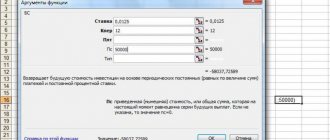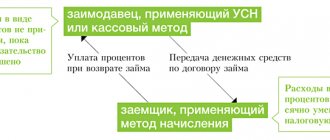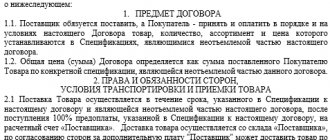Just like others
As a general rule, “input” value added tax is deductible if there is taxable turnover. At the same time, the Tax Code provides for cases when VAT is included in the cost of goods (clause 2 of Article 170 of the Tax Code of the Russian Federation): – if purchased (imported) goods are used for the production (sale) of non-taxable goods and (or) if the sale of such goods is specified in clause 2 Article 146 of the Tax Code of the Russian Federation; – if the goods are used for the production of products, the place of sale of which is not recognized as the territory of the Russian Federation; – if the goods were purchased by an organization that is not a VAT payer (for example, a “simplified” or “imposed”). Those organizations that initially purchased goods for sale subject to VAT, but then changed their minds, must restore the tax previously accepted for deduction. When VAT is and isn’t Often an organization has both taxable and non-taxable turnover. This happens, as a rule, when it applies special tax regimes along with the general taxation system. Moreover, let us remind you that the transition to “imputation” does not depend on the will of the organization. UTII, as is known, is introduced by decisions of legislative authorities (laws) in each region independently, and its payment and application are mandatory. If a company carries out both taxable and non-taxable transactions in one tax period (quarter), it needs to keep separate records for purchased goods (clause 4 of Article 170 of the Tax Code of the Russian Federation), but under one condition: they are used for taxable and non-taxable revolution at the same time. Keep in mind that if separate accounting is not maintained, then the amount of VAT charged to the company by the seller cannot only be deducted, but also included in income tax expenses (letter of the Ministry of Finance dated January 11, 2007 No. 03-07-15 /02). The Tax Code does not give a clear answer to the question of how to properly maintain separate accounting. The legislator proposed to decide on this issue independently, reflecting the necessary provisions in the accounting policy for tax purposes, but subject to the following condition: you need to start from the share of taxable turnover in the company’s total sales. The Federal Tax Service adheres to the same position in its letter dated May 27, 2009 No. 3-1-11 / [email protected] Do not forget that in order to avoid problems with the tax authorities, when calculating the cost of goods shipped for the quarter, you should take into account their price without VAT (letter from the Ministry of Finance dated August 18, 2009 No. 03-07-11/208 and Resolution of the Presidium of the Supreme Arbitration Court of the Russian Federation dated November 18, 2008 No. 7185/08).
Everything is deductible
From the provisions of Article 170 of the Tax Code, as from almost any rule, there is an exception. In our case, this is the so-called “5 percent rule”. According to it, if in the total volume of expenses for the quarter the share of expenses associated with operations exempt from VAT is no more than 5 percent, the entire “input” tax can be deducted.
| WHAT YOU NEED TO HAVE TO CREDIT INPUT VAT WHEN USING THE “5 PERCENT RULE” |
| • Certificate of calculation according to the methodology established in the accounting policy for tax purposes. The document must comply with Article 169 of the Tax Code of the Russian Federation and Decree of the Government of the Russian Federation of December 2, 2000 No. 914; • payment order with a bank mark (account statement) or another document confirming payment (receipt for a cash receipt order); • other documents confirming the actual receipt of goods (work, services) depending on the specifics of the expenses (for example, certificates of completed work in construction or hotel bills for the accommodation of posted workers). |
The fact is that the Tax Code gives an organization the right not to apply the provisions of paragraph 4 of Article 170 of the Tax Code of the Russian Federation (except for the “cherished” paragraph) to those tax periods (quarters) in which the share of total costs for the production of goods (work, services or property rights) , the sale of which is not subject to taxation, does not exceed 5 percent of all production expenses. Simply put, paragraph 4 of Article 170 of the Tax Code of the Russian Federation does not apply at all for those whose expenses for non-taxable turnover “fit” into the five percent criterion. It turns out that it is not necessary not only to include separate amounts of “input” tax in expenses, but also to keep separate records of taxable and non-taxable turnover (letter of the Ministry of Finance of Russia dated January 11, 2007 No. 03-07-15/02). The requirements for documents when applying for a deduction of “input” VAT in this situation are no different from the usual procedure provided for in Article 172 of the Tax Code (letter of the Federal Tax Service of Russia for Moscow dated October 20, 2004 No. 24-11/68949). A natural question arises. , how an accountant will determine the non-taxable percentage of turnover. And most importantly, how to prove all this to the tax inspector, who will one day come with an audit. Note that the calculation of the proportion for separate accounting is carried out “by income”, that is, depending on the taxable (non-taxable) sales volume. This is a general rule (clause 4 of article 170 of the Tax Code of the Russian Federation).
Consignments of goods for VAT accounting
It must be remembered that when selling goods, VAT is written off for a specific batch of a document - since for the correct calculation and distribution of the amount of incoming VAT, the program uses the “Batch” of each document. In order for accounting for VAT purposes regarding batches to coincide with regulatory accounting and cost calculation, it is necessary to use the FIFO method of accounting for PMZ.
In order to maintain batch accounting for inventory accounts, you need to set this option in the settings. This can be done in the menu “Administration” – “Accounting parameters” – “Setting up a chart of accounts” – “By item, batches, warehouses”. In the settings menu that opens, you must set the “By batches (receipt documents)” flag.
Example.
Organization A purchased chairs. November 1 – 10 pcs. at a price of 1180 rub. per piece, VAT on top, as well as on November 15 - 10 pcs. at a price of 1550 rub. per piece, VAT on top. Let's assume that the organization sold 15 units. 20 November.
If we maintain FIFO accounting, then for both VAT and costing purposes the chairs will be written off as follows:
- 10 pieces. from the batch at a price of 1180 rubles.
- 5 pieces. from the batch at a price of 1550 rubles.
And if an organization maintains accounting at average cost and separate VAT accounting, then for VAT purposes the program will write off data from batch documents, as described in the FIFO case, and for the purpose of calculating cost the following will be written off:
- 15 pcs. without batch, but based on the cost of 1365 rubles. (1180 + 1550= 2730 / 2 = 1365)
Thus, for the purposes of VAT accounting, the program will calculate based on batches, and for the cost price - based on other amounts. For sales transactions on the domestic market, this situation is not incorrect, but in the case of exports and the use of a 0% rate, difficulties arise, since confirmation of the zero rate will occur immediately for batches of all receipts stored on balances.
For this reason, those organizations that apply a 0% rate or without VAT are recommended to use the FIFO method instead of average cost accounting. If you change the method of accounting for inventories, do not forget to document this change in the form of an order for the accounting policy of the organization.
How to count
Another thing is the “5 percent rule”: here the calculation is carried out “based on expenses”. That is, the five percent barrier should not exceed the costs associated with the production (sale) of goods exempt from VAT (letters of the Ministry of Finance of Russia dated September 14, 2009 No. 03-07-11/223, dated April 1, 2009 No. 03- 07-07/26). Thus, it does not matter what the share in the structure of sales of products without VAT is. Another feature can be considered the ability to deduct VAT not only on indirect, but also on direct expenses (letter of the Federal Tax Service dated November 13, 2008 No. ШС-6-3 / [email protected] ). As we mentioned, formally, if this condition is met, there is no need to keep separate records. However, you will still have to determine the share of your expenses in some way. By analogy with those cases when maintaining separate accounting is mandatory, the editors recommend that the calculation procedure be fixed in the accounting policy for tax purposes. The amount of expenses should be determined excluding VAT. There is no consensus on whether to include all company costs or only direct costs in the calculation of expenses. Officials in their explanations require that the calculation take into account both general and direct expenses (letter of the Ministry of Finance of Russia dated December 29, 2008 No. 03-07-11/387). However, the courts look at this issue differently. Thus, the FAS of the Volga District, in its resolution dated July 23, 2008 No. A06-333/08, recognized the determination of the share of total expenses based on the amount of direct costs accounted for on account 20 “Main production” as legitimate. The arbitrators made a ruling based on the organization’s right to independently determine the method of calculating total expenses and the lack of legal regulation of this issue. According to the editors, in order to avoid problems with tax authorities, it is still worth taking into account both direct and indirect costs when calculating. There are no forms for calculating the share of expenses for non-taxable transactions approved by law or recommended by the regulator. Therefore, it is better to formalize the calculation using an accounting certificate (see Appendix 1).
Example of calculation using the 5% rule
TTT LLC conducts mixed operations – those falling under and not subject to VAT. Total expenses for the second quarter were:
- for taxable transactions - 10 million rubles;
- tax-free – 550 thousand rubles.
- general business – 1.6 million rubles.
Revenue:
- Taxable transactions – 11 million rubles;
- Non-taxable - 780 thousand rubles.
In accordance with the accounting policy provisions, the amount of general business expenses is distributed according to revenue for each type of transaction (with and without VAT).
The share of non-taxable transactions accounted for 1.06 million rubles. general expenses:
1.6 million x (780 thousand: (11 million + 780 thousand) = 1.06 million rubles.
Share of expenses for transactions excluding VAT = 0.14
(550 thousand + 1.06 million) : (10 million + 550 thousand +1.6 million) = 1,610,000 : 12,150,000 = 0.14
Since the result is much less than the 5% threshold, the entire input VAT can be deducted.
Nuances
Please note that, according to tax authorities and representatives of the Ministry of Finance, those who have been transferred to UTII have no access to the cherished “5 percent rule” (letter of the Federal Tax Service dated May 31, 2005 No. 03-1-03/897/ [email protected] and letter of the Ministry of Finance dated July 8, 2005 No. 03-04-11/143). However, the law says the opposite, because no one forbade “imputed persons” from being simultaneously VAT payers (clause 7 of Article 346.26 of the Tax Code of the Russian Federation). And the “5 percent rule” does not in any way limit the types of activities for which expenses are incurred. The main thing is that this activity is not subject to VAT. By the way, the judges are also on the side of taxpayers, as evidenced by the decisions of the Federal Antimonopoly Service of the North Caucasus District dated May 4, 2008 No. F08-2250/2008 in case No. A32-19085/2007-51/420 (upheld by the Determination of the Supreme Arbitration Court of the Russian Federation dated August 15, 2008 No. 10210/08), FAS Volga District dated February 5, 2008 No. A65-28667/06-SA2-11, FAS Northwestern District dated December 7, 2007 No. A05-5928/2007, FAS Volga-Vyatka District dated August 23, 2007 in case No. A82-6804/2005-99. Expenses for the acquisition of securities are not taken into account when determining the share of expenses for non-taxable turnover. The fact is that the costs associated with the acquisition of securities are not considered expenses for the production of goods, since they are accounted for separately in account 58 “Financial investments”. If such expenses are only the acquisition of securities, then the share of expenses for the production of goods that are not subject to taxation from the applicant will be equal to zero (Resolution of the Federal Antimonopoly Service of the Moscow Region dated February 29, 2008 No. KA-A40/1094-08 in case No. A40-15579/ 07-107-116). In the opinion of the editors, this circumstance makes it possible to deduct expenses for other goods (work, services) not related to the subsequent sale of securities. After all, only VAT charged on goods used in production can be deducted. There is also a peculiarity when providing loans. This operation is not subject to VAT (subclause 15, clause 3, article 149 of the Tax Code of the Russian Federation). When receiving interest-bearing loans, to calculate the five percent share of expenses, it is necessary to take into account not the entire loan amount, but only the interest for its use (letter of the Ministry of Finance dated April 28, 2008 No. 03-07-08/104). Vsevolod Zhuravlev Material provided by the magazine "Raschet"







